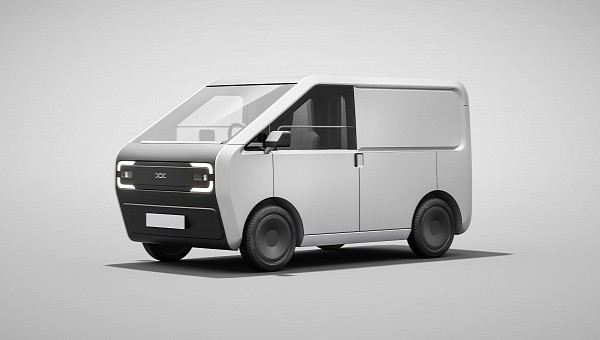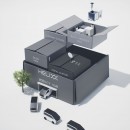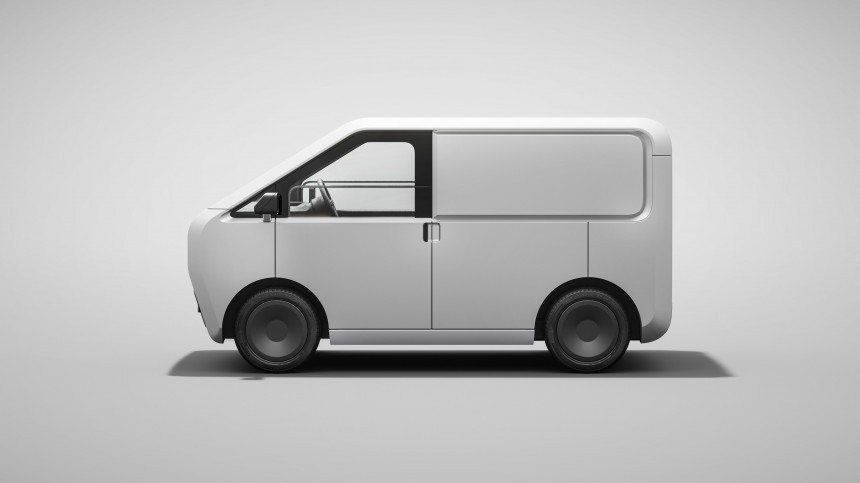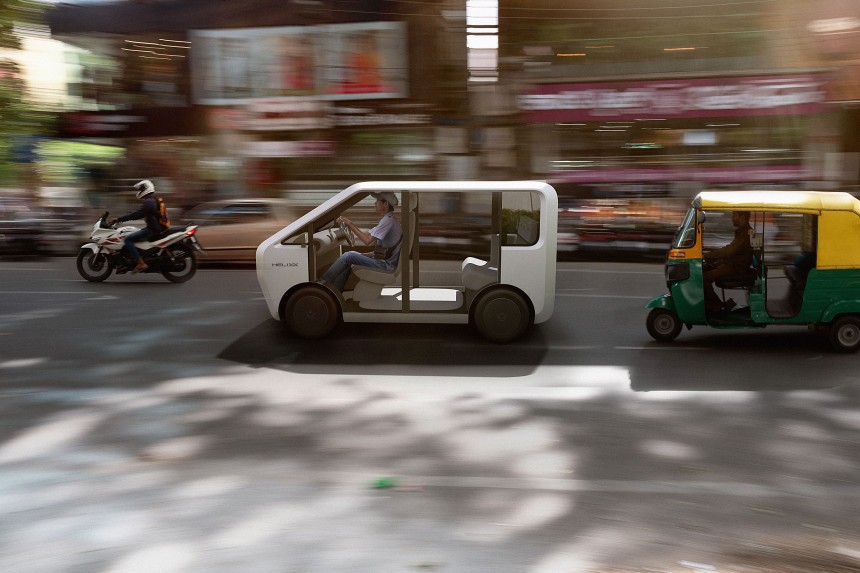The rise of the population across the globe is unstoppable, and urban areas are getting increasingly crowded. The U.N. predicts that 6.6 billion people will be living in urban areas by 2050. EVs with battery swap technology can prove to be an effective solution for commercial transportation in urban environments, as they maximize operational time and profitability. One company producing mini commercial EVs is Helixx.
Helixx is a UK-based global technology company producing a range of budget-friendly, innovative mini EVs. It aims to offer zero-emission mobility solutions to tackle air pollution in densely populated areas, enabling businesses to grow faster in developing regions.
Vehicle concept designer Steve Pegg and hypercar designers Jowyn Wong and Jakub Jodlowski are the minds behind Helixx. Wong and Jodlowski have vast expertise – their portfolio includes hypercars for manufacturers such as Apollo or De Tomaso.
The company has a range of four affordable mini commercial electric vehicles: Cargo, Truck, Ride, and Tuk. They’re relatively similar to each other, with each engineered to fulfill different purposes. Let me tell you a bit about them.
All four vehicles are built on the same platform. Design-wise, they are very straightforward, with styling that focuses on practicality. Designed to be as affordable as possible, they’re as small and simple as the majority of commercial vehicles. What sets them apart is their electric drivetrain and low pricing.
For instance, the Cargo is a commercial hood vehicle that boasts 2,100 liters (about 555 gallons) of cargo space and a 500 kg (1,102 lb) payload. It aims to support the booming demand for last-mile delivery fleets, as it can carry the majority of ISO pallets in target markets. The Cargo’s storage measures 140 cm (55 inches) in length, with a rear door width of 110 cm (43 inches).
On the other hand, the Truck is a pick-up ideal for construction businesses and urban developers. Its bed area offers 1.64 square meters (almost 18 square feet) of space and can carry the same maximum payload of 500 kg (1,102 lbs).
Then, we have the Tuk and Ride versions, which come in both open and closed-door body styles. They’re meant to be solutions for urban ride-hailing, replacing older, heavily polluting fleets. They can fit four passengers and provide 108 cm (42 inches) of legroom.
But here’s something that might get business owners excited - Helixx claims all four vehicles have a virtually uninterrupted 24-hour duty cycle. When you run out of juice, replace the LFP (Lithium Iron Phosphate) battery packs, and you’re good to go.
What’s special about this company? First, I must mention that Helixx aims to be a technology company, as it licenses its products and manufacturing to customers. Its products are designed to be built virtually anywhere in licensed Helixx Mobility Hubs. The vehicles will be provided on a subscription basis for commercial users starting at a price of $0.25 (€ 0.23) per hour.
Helixx Mobility Hubs are supported by a state-of-the-art digital ecosystem, which enables businesses to operate the hubs almost anywhere in the world via a licensed partnership. Helixx has designed the process to be as simple as possible, as it manages the entire onboarding process for hub partners. That means it takes care of everything from the establishment of the factory to the equipment installation and staff training. Furthermore, it will offer constant commercial support to local fleet operators.
The best part is that the manufacturing and operations hubs can be rapidly deployed – the delivery of the first models is estimated to take place within 180 days. Moreover, a circular manufacturing system is created, as vehicles can be recycled whenever needed.
The company even goes the extra mile by arranging all raw materials, components, and production processes through its next-gen digital platform. It prioritizes local sourcing and supply chain flexibility and keeps everything sustainable by maintaining complete traceability of environmental impact.
Helixx has successfully tested a UK concept hub in partnership with Siemens. Further plans include establishing pilot hubs in the UK and Singapore. What’s more, the company is discussing with customers in the Asia Pacific region. Other markets like India, MENA (Middle East/ North Africa), and South America will follow.
By scaling via licensed Helixx Mobility Hubs, implementation will take more time. However, the approach can prove to be beneficial in the long run for all the parties involved. Carbon emissions will be minimized, mobility will be improved, and enterprises can experience quick economic and social advancements, which are especially needed in developing regions.
Of course, change is usually hard to implement, especially in most regions Helixx is targeting. There, businesses have relied on the same solutions for a long time, and electrification isn’t widespread. However, if the company can prove its model can boost growth, it might have a chance at shifting customers’ perspectives and ending dependency on heavily polluting ICE vehicles.
Vehicle concept designer Steve Pegg and hypercar designers Jowyn Wong and Jakub Jodlowski are the minds behind Helixx. Wong and Jodlowski have vast expertise – their portfolio includes hypercars for manufacturers such as Apollo or De Tomaso.
The company has a range of four affordable mini commercial electric vehicles: Cargo, Truck, Ride, and Tuk. They’re relatively similar to each other, with each engineered to fulfill different purposes. Let me tell you a bit about them.
All four vehicles are built on the same platform. Design-wise, they are very straightforward, with styling that focuses on practicality. Designed to be as affordable as possible, they’re as small and simple as the majority of commercial vehicles. What sets them apart is their electric drivetrain and low pricing.
On the other hand, the Truck is a pick-up ideal for construction businesses and urban developers. Its bed area offers 1.64 square meters (almost 18 square feet) of space and can carry the same maximum payload of 500 kg (1,102 lbs).
Then, we have the Tuk and Ride versions, which come in both open and closed-door body styles. They’re meant to be solutions for urban ride-hailing, replacing older, heavily polluting fleets. They can fit four passengers and provide 108 cm (42 inches) of legroom.
But here’s something that might get business owners excited - Helixx claims all four vehicles have a virtually uninterrupted 24-hour duty cycle. When you run out of juice, replace the LFP (Lithium Iron Phosphate) battery packs, and you’re good to go.
Helixx Mobility Hubs are supported by a state-of-the-art digital ecosystem, which enables businesses to operate the hubs almost anywhere in the world via a licensed partnership. Helixx has designed the process to be as simple as possible, as it manages the entire onboarding process for hub partners. That means it takes care of everything from the establishment of the factory to the equipment installation and staff training. Furthermore, it will offer constant commercial support to local fleet operators.
The best part is that the manufacturing and operations hubs can be rapidly deployed – the delivery of the first models is estimated to take place within 180 days. Moreover, a circular manufacturing system is created, as vehicles can be recycled whenever needed.
The company even goes the extra mile by arranging all raw materials, components, and production processes through its next-gen digital platform. It prioritizes local sourcing and supply chain flexibility and keeps everything sustainable by maintaining complete traceability of environmental impact.
By scaling via licensed Helixx Mobility Hubs, implementation will take more time. However, the approach can prove to be beneficial in the long run for all the parties involved. Carbon emissions will be minimized, mobility will be improved, and enterprises can experience quick economic and social advancements, which are especially needed in developing regions.
Of course, change is usually hard to implement, especially in most regions Helixx is targeting. There, businesses have relied on the same solutions for a long time, and electrification isn’t widespread. However, if the company can prove its model can boost growth, it might have a chance at shifting customers’ perspectives and ending dependency on heavily polluting ICE vehicles.












